
SAINT OF THE DAY
The Lives of the Saints, Martyrs, Exemplars and Prophets of ANTINOUS the GAY GOD
Updated for Each Liturgical Feast Day
By
Antonyus Subia and Hernestus Gill
Priests of Antinous
FEBRUARY 12th

SAINT OF THE DAY
The Lives of the Saints, Martyrs, Exemplars and Prophets of ANTINOUS the GAY GOD
Updated for Each Liturgical Feast Day
By
Antonyus Subia and Hernestus Gill
Priests of Antinous

On February 12th the Religion of Antinous commemorates the brief life and tragic death of Saint Lawrence "Larry" King, the 15-year-old California schoolboy who was shot to death by a classmate after Larry had asked him to be his Valentine.
Two days before Valentine's Day 2008, 14-year-old Brandon McInerney sat down at a desk behind Larry in science class at a junior high school in Oxnard, California. Without saying a word, Brandon pulled out a .22-caliber revolver and shot Larry in the back. As Larry slumped to the floor amid screams from horrified students, Brandon quietly stood up and fired a "coup de grace" shot to the back of Larry's head, killing him.
Brandon had teased and taunted Larry for months, ridiculing Larry's sissified mannerisms. He attempted to enlist other boys to beat up Larry. When that failed for lack of interest, he decided to kill Larry and repeatedly vowed to "get a gun and shoot" him.
After weeks and months of teasing by Brandon and other male students who called him "faggot," Larry had started to retaliate by flaunting his sexuality. He wore make-up to school and taunted Brandon by making verbal passes at him.
The day before the shooting, the two boys were bickering during class. When Larry left, a student heard Brandon mutter, "I'm going to shoot him."

Just after that class, another student heard Larry say "I love you" to Brandon as they passed in a hallway. The same student then heard Brandon say he was "going to get a gun and shoot" Larry.
A few minutes later, Brandon told one of Larry's friends: "Say goodbye to your friend Larry because you're never going to see him again."
Larry's death struck a chord with parents, teachers, students and gay-rights advocates concerned that Brandon's bullying of him had been minimized by school authorities.
Since Larry's death, teachers have sought training in how to identify gay and lesbian students who might be struggling with their sexual identity. Teachers also have asked for resources to help students who have already come out or who may be experiencing bullying.
One of the many roles that Antinous the Gay God plays is the role of patron and protector of Troubled Gay Boys and also of Boys in Trouble for Gay-related things.
Larry lost his life because he dared to wear eye makeup and to ask another boy to be his Valentine.
And Brandon McInerney faces up to half a century in prison for murdering Larry.
Thus two young lives were destroyed by homophobia. It is because of cases like these that Antinous looks so mournfully wistful.
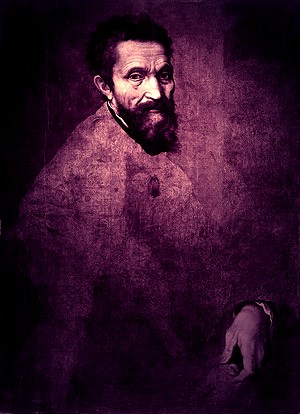
February 18th is the day when the Religion of Antinous honors Michelangelo, who died on this date.
Saint Michelangelo was the ultimate Renaissance Man, a painter/sculptor/architect/engineer, a man of art and science. A man torn between his passions and his religion. In the Renaissance, his voluptuous depictions of the male form were accepted as expressions of the Divine in art. It was the Victorians who went into denial over any hint that he may have been gay, despite the fact that he never married.
His male art is done with a passion for detail and obvious love of the male form. The only females he sculpted were maternal figures.
In 1532, he met a handsome young nobleman called Tommaso de Cavalieri. Michelangelo was struck by a romantic feeling that simply would not go away. He wrote sonnet after sonnet for the man as well as producing some rather "personal" sketches for his eyes only.
Michelangelo executed a number of exquisite ink sketches of Jove's Abduction of the beautiful youth Ganymede.
Michelangelo most certainly knew that Jove and Ganymede were synonymous with Hadrian and Antinous. As a man of art and science, all he had to do was look at the nighttime sky and see the Constellation of Antinous (formerly the Constellation of Ganymede).

An older man enthralled with a handsome youth. Our modern concept of "gayness" did not exist. But did he really have to spell it out to Tommaso any more clearly than that?
For thirty-odd years, the two were constant companions, but Michelangelo? s passions did not end there. During his relationship with Cavalieri, he also wrote about some deep feelings for other men in his life, including the 16-year-old Cecchino dei Bracci, for whom he wrote 48 funeral epigrams after his untimely death.
Here is an extract from one of his same-sex love sonnets:
"The love I speak of aspires to the heights; woman is too dissimilar, and it ill becomes a wise and manly heart to burn for her."
For his gentle genius and for his love of male beauty and for representing the best strivings of humanity, we proclaim Michelangelo di Lodovico Buonarroti Simoni one of our Blessed Prophets of Homoeros.
Michelangelo reminds us that male beauty IS divine.
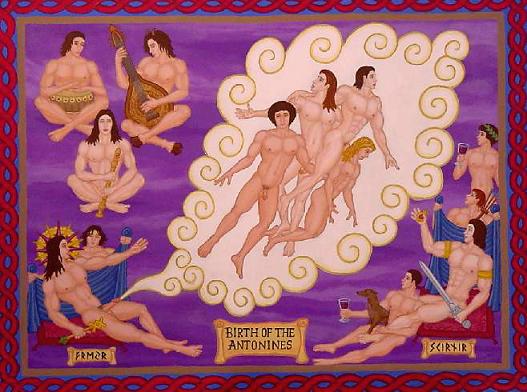
On February 28th and March 1st the Religion of Antinous marks Three Holy Days involving the Divine Antoninus Pius.
On February 28th we celebrate the Adoption of Antoninus Pius by Hadrian. And on March 1st we commemorate the Apotheosis of Antoninus Pius . Also on March 1st, we celebrate the Ascension of Marcus Aurelius and Lucius Verus.
After the death of Aelius Caesar, Hadrian adopted Antoninus, imposing on him the condition that he adopt two sons, Lucius Verus and Marcus Antoninus to be his successors. Antoninus supported the dying Hadrian for the remainder of his years, and obeyed his commands even after his death. For this Antoninus is called Pius.
As the Fates would have it, March 1st is the date when Antoninus Pius died in 161 AD after 23 years as Emperor. His rule is marked by an almost unbroken period of peace and tranquility. The golden era of Rome, known as the Age of the Antonines, takes its name from Antoninus, because every emperor afterward took up his name as an emblem of glory. Antoninus is the emperor most responsible for the perpetuation of the Religion of Antinous.
He had served as Proconsul of Asia Minor under Hadrian from 130 to 135, while the Religion of Antinous was being formed, and it was during his reign that construction of the Sacred City of Antinoopolis was completed.
The Senate deified Antoninus Pius shortly after his death. The base of the column erected in his honor, shows Antoninus Pius and his wife Faustina the elder, rising up to heaven. They are ascending upon the wings of an Aeon, with Mother Rome on one side, and a beautiful reclining male figure on the other who grasps an obelisk. We believe this figure to be Antinous, guardian spirit of the Age of the Antonines.
Upon the occasion of the Death and Apotheosis of Antoninus Pius, Marcus Aurelius and Lucius Verus became co-Emperors, both surnamed Antoninus, a name which the ancient Romans equate with inestimable glory.
Marcus being the elder and wiser, was given the title Augustus, while Lucius took the name Caesar. They remained cordial to one another though their vastly different characters were always a cause of discord, though never of rivalry or outright animosity. They were a harmonious and cooperative pair of rulers, the only example of effective imperial brotherhood in the long history of Rome.
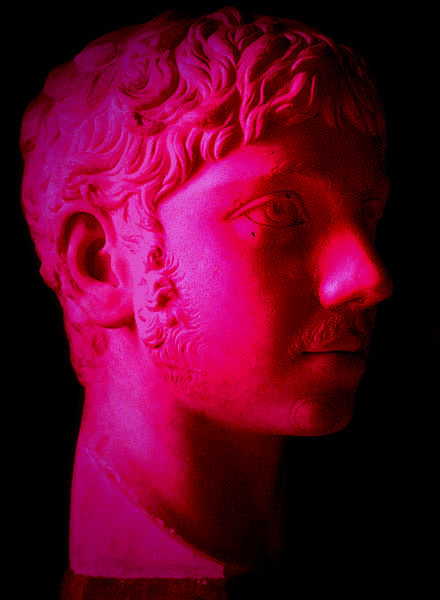
On March 11th the Religion of Antinous solemnly commemorates the Assassination of the Emperor Elagabalus.
Imperator Caesar Marcus Aurelius Antoninus Augustus was born on an unknown date in the winter of 204 AD in the city of Emesa in Syria. His birth name was Varius Avitus Bassianus, and he is believed to have been the son of Caracalla, for which reason he was declared Emperor by the Legions of Syria during an uprising against the short-lived Emperor Macrinus who had assassinated Caracalla and taken the throne.Varius Bassianus was only 14 years old when he became sole ruler of the Roman Empire and took the name of Antoninus. He was the last Emperor to bear the sacred name of the most glorious rulers of the world, the Antonines. He is known to history as Elagabalus, because he was from birth the high priest(ess) of the androgynous sun deity Elagabal.
He brought his strange, phallic religion to Rome, and very shortly began to impose Elagabal, going so far as to nullify all other cults and force the Romans to accept his one god. It is even claimed that he closed and demolished the temple of Antinous at Tibur and perhaps others, but this is rumor.
What Elagabalus is famous for is that he was an extreme homosexual phallus worshipper with an insatiable fondness for chariot racers who he often elevated to the highest positions of authority simply based on the size and grace of their penises. He is criticized by ancient historians for portraying himself as Venus on Mount Ida, and allowing himself to be sodomized on stage by his chariot racers in the roles of various gods in full view of an audience.
History is slanted by anti-tranny prejudice. Elagabalus is recorded as having been one of the most infamous and degenerate figures in Roman history. This despite the fact that he was not particularly cruel or demonstrably mad. He simply offended the sensibilities of later historians ? particularly Victorian historians who were appalled by the fact that a trans teen had been acclaimed emperor of Rome.
Elagabalus, devoted to the androgynous god Elagabal, made it his priority as emperor to demote all others gods and goddesses to the position of servants to the principal deity. A black stone phallic representation of the god was processed through the streets of Rome to the temple annually.
Many of the sacred symbols of other religions were moved to the temple of Elagabal, including those of Jews and Christians. To persuade followers of other deities to worship Elagabal, the emperor participated in the rituals of several other religions. On a daily basis animal sacrifices were performed, consistent with the practices of many of the religions.
Victorian historians record Elagabalus' life as scandalous, yet an examination of their remarks reveal a troubled trans youth struggling with his identity:
"Not only was he bi-sexual, but also a transvestite. He would go to the taverns at night wearing a wig, woman's clothes and makeup and ply the trade of a prostitute. This activity only ended when he met Hierocles, a Carian slave, and became his wife. Hierocles was even permitted to beat the emperor when displeased, as any man might beat his wife. Even more scandalous Elagabalus not only acted and dressed like a woman, but he wanted to be physically transformed into one. He asked his physicians to contrive a vagina for him, promising huge rewards for success."

In other words, he was a transgender teenager who had the power and money at his disposal to create the gender-bending reality he desired to live in.
At the age of 14, in 218, Elagabalus, a zealous believer, declared a religious initiative giving Elagabal precedence over all other gods, even Jupiter himself. The god was also to have a consort. Pallas Athena was the first choice, a goddess tended by the Vestal Virgins. As part of his strategy Avitus married one of the vestals. When Romans balked at the violation of a vestal virgin, however, he opted for the symbolic marriage with Urania, a moon goddess.
His attempt to unify Rome under one religion met with strong resistance and did nothing to moderate his unpopularity. In the very year that Elagabalus became emperor, the Third Legion, which had placed him in office, attempted to replace him with Verus, their commander. The attempt failed. Over time, subsequent attempts by the Fourth Legion, by the fleet, and by a pretender named Seleucus also failed.
But as unpopular as he was with the nobility and commanders of the Legions, he was not at all unpopular with the plebs, upon whom he lavished gifts and games.
As emperor he had a Temple built to Elagabal, restored the Flavian Amphitheatre (the Colosseum) that had been damaged by fire and completed the construction of the public baths of Caracalla in the Vicus Sulplicius. He also had built a palace complex, the Horti Variani, with an amphitheatre, a circus, a bath, and audience hall.
His most famous projects, however, were the temple of Elagabal (the Elagaballium) on the Palatine hill (shown above) and another such temple on the southeastern edge of the city. From these temples the emperor delivered largesse to crowds that gathered below.
None of his works, or gifts to the people, were sufficient to offset his reputation among the elite, tarnished by his promiscuous behavior with men and women. But just imagine, wouldn't most teenage boys be self-indulgent if they suddenly found themselves with absolute powers? Many of the adult emperors did no less.
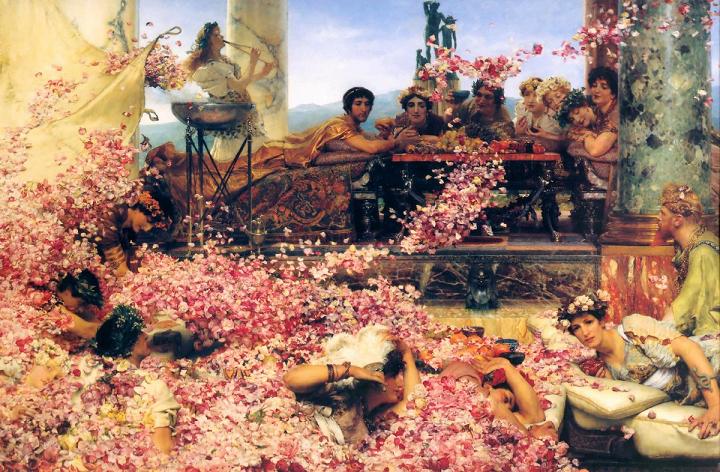
Many legends have arisen about the decadent lifestyle of Elagabalus, including the tall tale that one of his palace orgies was the scene of an inadvertent massacre when so many flower petals were showered upon the banquet guests that dozens of people suffocated to death as they reclined on their couches.
A colossal, wall-sized painting of this scene by Lawrence Alma-Tadema (shown at left) shocked and titillated Victorian viewers.
As the young emperor's popularity dwindled, his mother Julia Soaemias and other supporters recognized that the royal family was in danger of their lives.
Rome had a tradition of murdering unpopular emperors, and sometimes their adherents as well.
In hopes of rescuing the regime, his close family and supporters induced Elagabalus to adopt his cousin Bassianus Alexianus, a young man popular with the Praetorian Guard, and name him Caesar, heir to the throne.
The scheme backfired in that Julia Mamaea, Alexianus's mother, was as ambitious as Julia Soaemias and desired to see her son emperor as quickly as possible. Mamaea, playing on the Praetorians' contempt for Elagabalus, connived for the assassination of Elagabalus. Soaemias, discovering the adoption had created greater danger not less, urged Elagabalus to have his cousin killed lest he himself be murdered. However, no one would obey the order.
Here is where we catch up with Julia Soaemias and Elagabalus:
"Mother," spoke the young emperor, 17 years old, the glow of childhood still reflected in his eyes, "they don't understand what I want to accomplish. If they did, they wouldn't hate me."
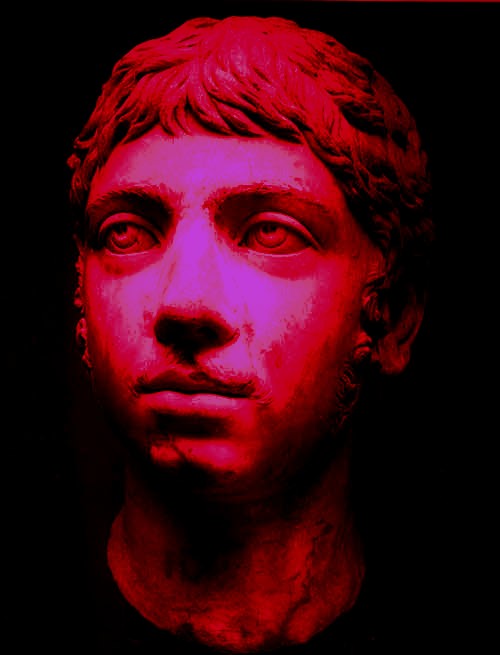
"Child," replied Julia Soaemias, "they have more than one reason to hate you. You're obsessed with being a woman and you flaunt Roman tradition. You seek to bring down their gods and make them slaves to Elagabal. Elagabal knows I worship him as much as you, but he wants not that we place him above other gods."
Elagabalus paused, then added: "I will go to the praetorian camp and entreat with them, explain what I intend. Surely they will listen. A single god for all Rome would unify us as naught else might. Our former glory would be restored and Rome would endure forever. I will go. I will go now! The armies must be made to understand," declared the emperor, rising from his throne even as he spoke.
"If you go to the guard they are as likely to kill you as listen to you," admonished his mother.
"That is a chance I must take," he retorted, "Rome is more important than my life."
At the Praetorian camp:
"All hail Nellie Ellie," sarcastically called a guardsman upon the approach of the emperor. "Run, fear for your manhood, she comes to drain us dry," yelled another voice.
Other guardsmen laughed and joined in, a little nervously at first ? after all, this was the emperor of Rome ? but with growing enthusiasm.
Stepping down from his chariot, Elagabalus, dressed as a woman, his wig meticulously styled and his makeup artfully done, spoke in a loud voice, "I have come to discuss with you the fate of Rome."
His mother, having accompanied him stepped down beside him, on her countenance fear was plainly written. She had a bad feeling about what could happen that night and the crowd of soldiers mocking and jeering did nothing to lessen that fear.
"Alexianus would have me murdered and restore the old gods, the many religions which kept Romans apart. I have dedicated my rule to bringing our great nation together under one god, you must see the wisdom in such a venture," he called out in a loud voice, ignoring the insults and belittling remarks.
"Wisdom from a boy whore," yelled out a disgruntled soldier, "Drunk one night, boy, I had you. Was that your wisdom, Nellie Ellie?" The crowd laughed uproariously.
"I am the priestess of Elagabal. It is my place to be among my people, to suffer the worst and the best at your hands. I am also your emperor and I command you to kill my rival, Alexianus," he ordered.
His mother leaned forward and whispered in his ear, "Tread softly my son, their temper is not to be trifled with. I like not their mood."
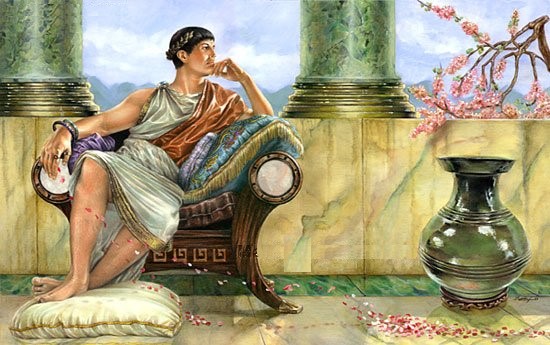
"You have had my spear once, priestess," venomously spat a soldier near the front of those gathered. "Now have another!" As the soldier uttered the words he hurled a spear. It landed to one side, but came perilously close to hitting Elagabalus.
"I want nothing but the betterment of Rome," shouted Avitus, taking his mother by the arm and retreating to his chariot. Too late he took the reins of his spirited horses, the soldiers had already surrounded his chariot and taken control.
"You will agree to abdicate in favor of Alexianus before you leave this night, or you shall not leave," spoke up the closest of his adversaries. The army heard the words and began to chant, "Alexianus, Alexianus, Alexianus."
Enraged, the youthful emperor screamed, "I am emperor. It is I who know what is best for Rome. Not you traitors. Now, let go of my horses!"
With his whip he struck at the face of the nearest soldier, landing a vicious blow that brought blood. The soldier in turn pulled Elagabalus from the chariot and stabbed him. Others joined in. The last thing Elagabalus saw before he died was the soldiers pulling his mother from the chariot.
"Let my mother be," he tried to yell, but only a whisper passed his lips.
So ended the reign of the trans teenage Varius Avitus Bassinus, having ruled Rome for but four years. He had been the first emperor to attempt to unify Rome under one god. His gender variance, his sexual escapades ? frowned upon but tolerated ? had destroyed his credibility. After the murders, his body and that of his mother were dragged naked through the streets of Rome. Finally, beheaded, both bodies were thrown into the Tiber, the punishment for convicted criminals.
Elagabalus reigned only four years, and was 18 years old when he was murdered, the same age as Antinous. Though his character is condemned as perverse, the open phallicism that he imposed upon Rome, and the dramatic exhibition of his homosexuality warrant his deification, and he was the Last of the Antonines.
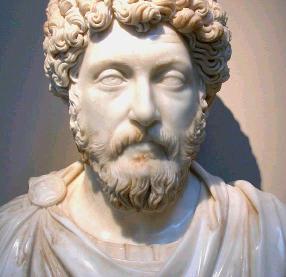
On March 17th, the Religion of Antinous solemnly mourns the death of one of the Divine Hadrian's most glorious hand-picked successors, the Emperor Marcus Aurelius.
Chosen by Hadrian as a boy to become emperor one day, Marcus Aurelius had ruled alone since the death of Lucius Verus in 169AD.
Most of his reign was spent fighting and negotiating with the Germanic barbarians who were steadily crowding around the borders of the Empire. Marcus was able to hold them back with a succession of victories and peace treaties.
In 177 he made his son, Commodus, joint-Emperor, although Commodus had no interest in the responsibility, caring more for the gladiatorial sports. But Marcus, the philosopher-king, took no notice of his son's blood-lust, which was to later cost the Empire dearly.
For much of his reign, Marcus Aurelius had suffered from severe illness, but his calm devotion to stoic virtue gave him the strength to continue without rest and without his poor health interfering with his duties.
It was while he was with the legions on the German frontier that Marcus Aurelius suddenly died on March 17th in the year 180AD. His ashes were conveyed to Rome and placed in Hadrian's Mausoleum.
Commodus assumed power and began the chain of tragic events that are said to have brought the decline and fall of the Roman Empire.
For his wisdom, and strength, and because he was the last instrument of Hadrian's plan that brought so much glory, and prosperity to Rome, we venerate the deified Marcus Aurelius as a god of the Religion of Antinous.

Saint Charlotte von Mahlsdorf, who was born on this day in 1928, was a Berlin trans/gay who survived the Nazis and East German communists and about whose life a Pulitzer Prize winning play, "I Am My Own Woman", has been staged at theatres around the world.
The title is misleading since the original German is "Ich bin meine eigene Frau" and the word "Frau" can mean either "Woman" or "Wife". The phrase was Charlotte's answer to her mother's question: "Don't you think it's time you got a wife?"
Charlotte was her own man and her own woman and her own husband/wife. In a long life amidst dictatorship, war and oppression of human-rights, Charlotte learned to create her own identity. We honor Charlotte as a Saint of the Religion of Antinous.
St. Charlotte, who liked to wear frumpy house dresses with a clunky handbag and a strand of pearls and matronly shoes, somehow managed to survive the Gestapo, the East German Stasi secret police and assaults by neo-Nazis. In doing so, Charlotte made serious ethical compromises along the way in order to stay alive. Charlotte amassed a huge collection of Victorian antiques which some said came from the homes of Jewish Holocaust victims and (later) from homes of people fleeing East Germany.

But Charlotte DID stay alive in dangerous times during which others perished. Charlotte's life forces you to ask yourself what YOU would have done in similar circumstances.
After German unification, Charlotte became something of a reluctant gay icon in Germany in the 1990s. Charlotte never had any pretensions of being intellectual or a political activist. Charlotte never quite fit in with post-Stonewall activists, who were a bit puzzled by her dowdy grandmotherliness and her passion for 19th Century Renaissance Revival style antiques. Like Quentin Crisp (also a Saint of Antinous), Charlotte belonged to another era.
But unlike Quentin Crisp, Charlotte wasn't especially witty or campy (despite her appearance) and was not an artist of the arch one-liner the way Quentin was. In appearances on talk shows, she would sit there, smiling politely, with not a great deal to say unless it was about collecting and restoring 19th Century antiques. But what she did say was eloquent in its simplicity: People should be kind to each other and let each other get on with their lives the way they want to.
Above all, she didn't much like being a celebrity. Too many people expected things of her. She became a target for neo-Nazis, mostly drunken, youthful vandals in the 1990s. Not surprisingly perhaps, considering all she had lived through, she became somewhat paranoid towards the end of her life. In the end, she fled to Sweden where she spent her final years in virtual isolation before dying in 2002.
We honor St. Charlotte von Mahlsdorf for being someone who was not afraid to be openly trans/gay in the face of totalitarian dictatorships and police states. Someone who survived the Nazis and the Stasi secret police ? wearing a dress, a strand of pearls and a handbag.
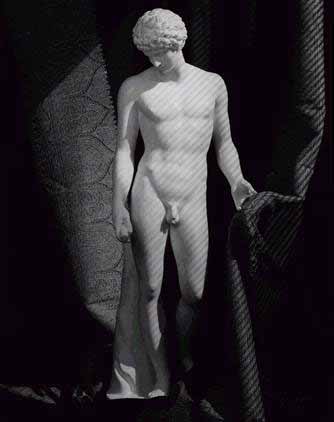
On March 19 the Religion of Antinous honors Robert Mapplethorpe, Saint of Antinous.
In 1990, the Cincinnati Contemporary Arts Center and its director were charged with "Pandering Obscenity" after an exhibition of Mapplethorpe?s photographs. They were eventually acquitted but the event fueled a national debate over federal funding of the arts in the United States. The debate, which has affected American art ever since, focuses on whether tax dollars should be spent on projects which political conservatives deem objectionable. Specifically, the debate is over whether gay-theme art should be funded.
Robert Mapplethorpe died from AIDS on March 19th, 1989, one year before his art spawned the controversy, so he was only able to speak through his photographs.

His subject matter portrayed homosexually charged images of nude men, and S&M including the infamous "Self-portrait with Bullwhip" (shown at right).
The controversy that Robert Mapplethorpe sparked exposed the double standard by which homosexual art is judged against heterosexual art. He revealed that nudity is most "obscene" to non-gays when it involves males.
We proclaim his sainthood to be heroic and dedicated to Antinous, because Robert Mapplethrope beautifully photographed a plaster statue of Antinous (shown at left), indicating that he must have known our God and in some way loved him.
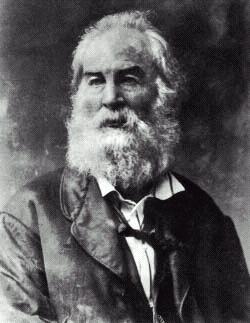
On March 26th the Religion of Antinous takes a moment to celebrate the life of one of our most popular Antinoian prophets ? Saint Walt Whitman.
Walt Whitman was born on May 31, 1819, on the West Hills of Long Island, New York. He was lavished with love by his mother, but treated with stern discipline by his carpenter father.
After only a few years of school, Whitman was pulled out to help with the family earnings. He educated himself, reading all that he could, worked in a printing house, and eventually became a schoolteacher who taught with refreshing openness and excitement, allowing his students to call him by his first name. After years of teaching, he went into journalism, and in time was the editor of several publications.
However, Walt Whitman is said to have experienced a life-transforming epiphany. He left New York, and returned to live for a period with his family, then returned from isolation with Leaves of Grass, one of the most powerful collections of poems in American literature and the first to allude heavily to homosexual love.

It is often said that, during his time in isolation, a religious sense of purpose entered his heart, which he revealed in the Calamus poems.
The aromatic, psychotropic calamus plant with its phallic spadix flower pods was his symbol for homosexuality. The calamus has special meaning for us because Kalamos of Greek myth fell in love with the beautiful youth Karpos. Like Antinous, Karpos died by drowning. Grief-stricken Kalamos wept among the reeds at the waterside until he was himself transformed into a reed, whose rustling in the wind is his sigh of woe.
When the American civil war broke out, Walt Whitman was 42 years old and served as a hospital nurse, falling in love with all the soldiers, especially those who died in his arms.
Open expressions of love between men were accepted without issue during the war, and it was when the visionary enlightenment of Walt Whitman became clear to him. He saw that the origin of this love, brotherly, or friendly perhaps, if not more, was the salvation of the human race, and certainly able to heal the divide between North and South.
His final years were spent communicating his message to the new torchbearers, such as John Addington Symonds and Edward Carpenter. After his death, and as Gay Liberation took strength, he was called a Prophet, particularly by the George Cecil Ives and the Order of Chaeronea.
We, adherents of the ancient/modern Religion of Antinous, proclaim him to be St. Walt Whitman the Prophet of Homoeros, and we elevate him to his own stratosphere in our devotion.
He died March 26th, 1892 of tuberculosis compounded by pneumonia. Over 1,000 mourners paid their respects. St. Walt told us how he wanted us to remember him, not as a great poet, but as "the tenderest lover":
You bards of ages hence! when you refer to me, mind not so much my poems,
Nor speak of me that I prophesied of The States, and led them the way of their Glories;
But come, I will take you down underneath this impassive exterior ? I will tell you what to say of me:
Publish my name and hang up my picture as that of the tenderest lover,
The friend, the lover's portrait, of whom his friend, his lover, was fondest,
Who was not proud of his songs, but of measureless ocean of love within him ? and freely poured it forth,
Who often walked lonesome walks, thinking of his dear friends, his lovers,
Who pensive, away from one he loved, often lay sleepless and dissatisfied at night,
Who knew too well the sick, sick dread lest the one he loved might secretly be indifferent to him,
Whose happiest days were far away, through fields, in woods, on hills, he and another, wandering hand in hand, they twain, apart from other men,
Who oft as he sauntered the streets, curved with his arm the shoulder of his friend ? while the arm of his friend rested upon him also.

On March 31st the Religion of Antinous solemnly commemorates the glorious life and cruel death of Saint Hypatia of Alexandria.
Hypatia is one of the most important female philosophers who ever lived, and her tragic murder at the hands of fanatical Christians on the steps of the Great Library of Alexandria is symbolic of the barbaric forces which brought down the worship of Antinous and other Classical deities.
The brutal stoning-flaying-immolation death of Hypatia in about the year 400 AD is regarded by many historians as the beginning of the Dark Ages.
St. Hypatia was a philosopher and mathematician who lived in Alexandria during a time of turmoil and conflict between Christians and the last pagan philosophers of the Great Library.
Her father was the Philosopher Theon, and Hypatia studied among the Neoplatonists. She was the author of several highly reputed works and commentaries, none of which has survived. She held a reputation of excellence that exceeded her contemporaries.

Hypatia taught among the male philosophers and attracted a large following even among Christians. Her beauty was highly desired by numerous men, but she remained chaste (or at least unmarried) all her life, which leads some to suspect lesbianism.
The proud life of Hypatia came to an end at the end of March during the season of Lent when she was attacked by a Christian mob, led by a fanatic Deacon named Peter, who dragged her through the streets to a church called Caesareum. There she was stripped naked and killed by the mob with their bare hands. It was said that they stoned her with ceramic roof tiles, then flayed her flesh with razor-sharp shards of oyster shells, tore her limb from limb and burned her.
?Saint? Cyril, Bishop of Alexandria, who encouraged her assasination, was then praised for eradicating the city of ?idolatry and witchchraft?.
The Martyrdom of St. Hypatia of Alexandria is one of the most profound examples of Christian violence against paganism, women, and philosophy. And she is noted as one of the last reasoning pagans murdered by the irrational religion which has dominated Western Civilization ever since.
Her death is among the heinous crimes of the Christian Church, whose attrocities continue to this day. The image at right, by Charles William Mitchell, portrays Hypatia just before her death, naked at the altar, imploring her attackers to take heed of their own faith?which they continue to ignore.
For these reasons and in memory of the unnamed Ancient Priests of Antinous who suffered similar fates, the Religion of Antinous has proclaimed Hypatia of Alexandria a Saint and Venerable Exemplar and honors her with a Feast Day on March 31. As Sacred Synchronicity would have it, her Antinoian Feast Day in 2009 coincided with the release of major motion picture based on her life.
Openly gay Chilean-Spanish filmmaker Alejandro Amenábar's $75-million production AGORA stars Oscar-winning actress Rachel Weisz and was the biggest box-office hit in Spain for the year 2009.
In the film set in Roman Egypt in the final days of the 4th Century A.D., Weisz plays the astrologer-philosopher Hypatia of Alexandria, who fights to save the collected wisdom of the ancient world. Her slave Davus (Max Minghella) is torn between his love for his mistress and the possibility of gaining his freedom by joining the rising tide of Christianity.
